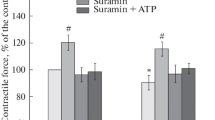Summary
Specific effects of narcotics (opiates) were studied on rat extensor alpha-motoneurones. The animals were anaesthetized with halothane, artificially ventilated and immobilized with N,N′-diallyl nortoxiferinium-HCl. The alpha-motoneurones were activated by tetanic stimulation of the cut ipsilateral gastrocnemius-soleus (GS) nerve. Morphine (2 and 4 mg/kg) administered intravenously, significantly increased the frequency of reflex discharges. In most of the neurones tested, naloxone (0.25 mg/kg) given intravenously, abolished the effect of morphine. In some neurones, however, naloxone induced a further activation. The dose of naloxone employed was ineffective when given alone. The effect of morphine was mimicked by an intravenous injection of levorphanol (1 mg/kg), but not by an equimolar dose of the stereoisomer dextrorphan, which suggests that the activating effect on alpha-motoneurones is a specific one. An intraperitoneal injection of apomorphine (1 mg/kg) reduced the effect of morphine. The effect of narcotics on alpha-motoneurones parallels narcotic-induced catalepsy and muscular rigidity, with regard to dose-dependence as well as to the antagonism of naloxone and apomorphine, and suggests that both catalepsy and muscular rigidity are mainly due to an activation of extensor alpha-motoneurones. Since this activation can be inhibited by spinalization of the rats, it can be concluded that the activation is due to a supraspinal action of morphine, resulting in a decreased dopaminergic neurotransmission in the brain.
Similar content being viewed by others
References
Akil, H., Mayer, D. J., Liebeskind, J. C.: Antagonism of stimulation-produced analgesia by naloxone, a narcotic antagonist. Science 191, 961–963 (1976)
Andén, N.-E., Rubenson, A., Fuxe, K., Hökfelt, T.: Evidence for dopamine receptor stimulation by apomorphine. J. Pharm. Pharmacol. 19, 627–629 (1967)
Arvidsson, J., Jurna, I., Steg, G.: Striatal and spinal lesions eliminating reserpine and physostigmine rigidity. Life Sci. 6, 2017–2020 (1967)
Arvidsson, J., Roos, B.-E., Steg, G.: Reciprocal effects on alpha and gamma motoneurones of drugs influencing monoaminergic and cholinergic transmission. Acta physiol. scand. 67, 398–404 (1966)
Carlsson, A., Lindqvist, M., Magnusson, T.: 3,4-Dihydroxyphenyl-alanine and 5-hydroxytryptophan as reserpine antagonists. Nature (Lond.) 180, 1200–1201 (1957)
Celsen, B., Kuschinsky, K.: Effects of morphine on kinetics of 14C-dopamine in rat striatal slices. Naunyn-Schmiedeberg's Arch. Pharmacol. 284, 159–165 (1974)
Davies, J., Duggan, A. W.: Opiate agonist-anatagonist effects on Renshaw cells and spinal interneurones. Nature (Lond.) 250, 70–71 (1974)
Duggan, A. W., Curtis, D. R.: Morphine and the synaptic activation of Renshaw cells. Neuropharmacology 11, 189–196 (1972)
Ernst, A. M.: Mode of action of apomorphine and dexamphetamine in gnawing compulsions in rats. Psychopharmacologia (Berl.) 10, 316–323 (1967)
Grossmann, W., Jurna, I., Nell, T., Theres, C.: The dependence of the anti-nociceptive effect of morphine and other analgesic agents on spinal motor activity after central monoamine depletion. Europ. J. Pharmacol. 24, 67–77 (1973)
Herz, A., Albus, K., Metys, J., Schubert, P., Teschemacher, Hj.: On the central sites for the antinociceptive action of morphine and fentanyl. Neuropharmacology 9, 539–551 (1970)
Jurna, I.: Striatal monoamines and reserpine and cholorpromazine rigidity. Pharmac. Ther. B 2, 113–128 (1976)
Kuhar, M. J., Pert, C. B., Snyder, S. W.: Regional distribution of opiate receptor binding in monkey and human brain. Nature (Lond.) 245, 447–450 (1973)
Kuschinsky, K.: Actions of narcotics on brain dopamine metabolism and their relevance for “psychomotor” effects. Arzneimittel-Forsch. (Drug Res.) 26, 563–567 (1976)
Kuschinsky, K., Hornykiewicz, O.: Morphine catalepsy in the rat: Relation to striatal dopamine metabolism. Europ. J. Pharmacol. 19, 119–122 (1972)
Steg, G.: Efferent muscle innervation and rigidity. Acta physiol. scand. 61, Suppl. 225 (1964)
Wand, P., Kuschinsky, K., Sontag, K.-H.: Morphine-induced muscular rigidity in rats. Europ. J. Pharmacol. 24, 189–193 (1973)
Zieglgänsberger, W., Bayerl, H.: The mechanism of inhibition of neuronal activity by opiates in the spinal cord of cat. Brain Res. 115, 111–128 (1976)
Author information
Authors and Affiliations
Additional information
These studies were supported by a grant (B-3) of the SFB-33 “Nervensystem und biologische Information” of the Deutsche Forschungsgemeinschaft.
Rights and permissions
About this article
Cite this article
Kuschinsky, K., Ropte, H., Meseke, R. et al. Specific action of narcotics on reflex activation of rat alpha-motoneurones. Naunyn-Schmiedeberg's Arch. Pharmacol. 296, 249–254 (1977). https://doi.org/10.1007/BF00498690
Received:
Accepted:
Issue Date:
DOI: https://doi.org/10.1007/BF00498690




